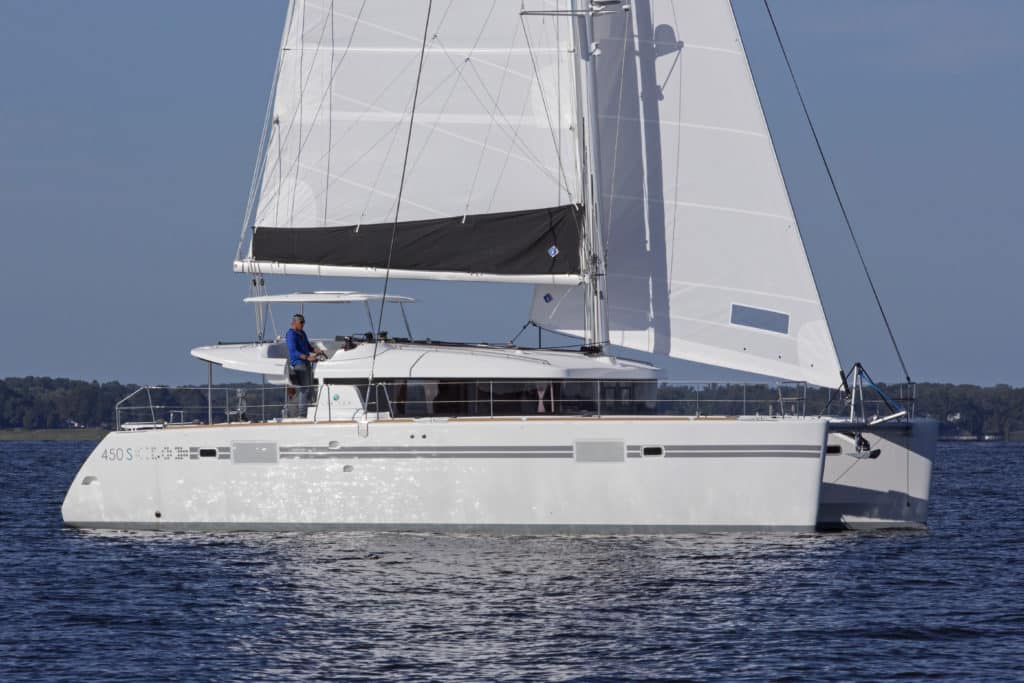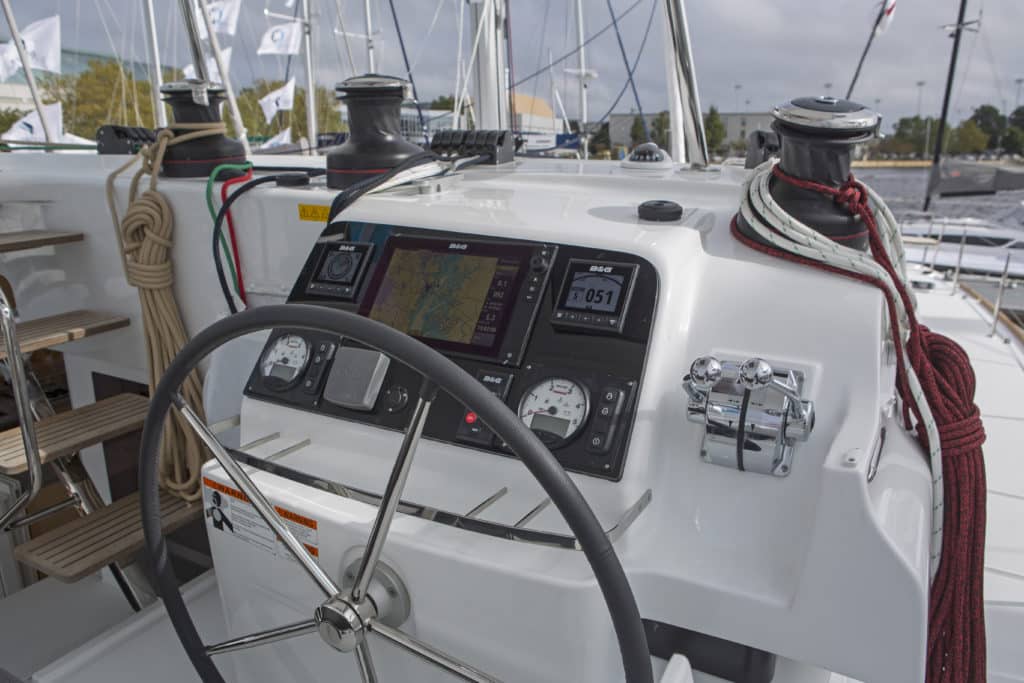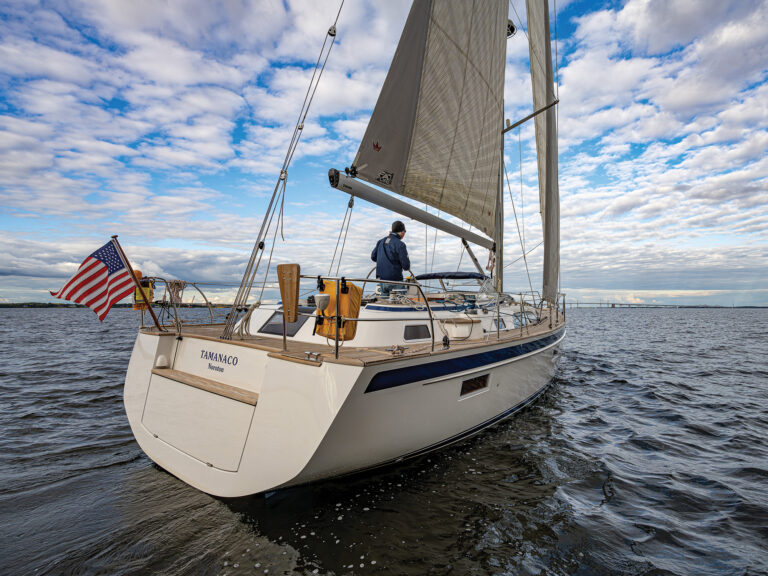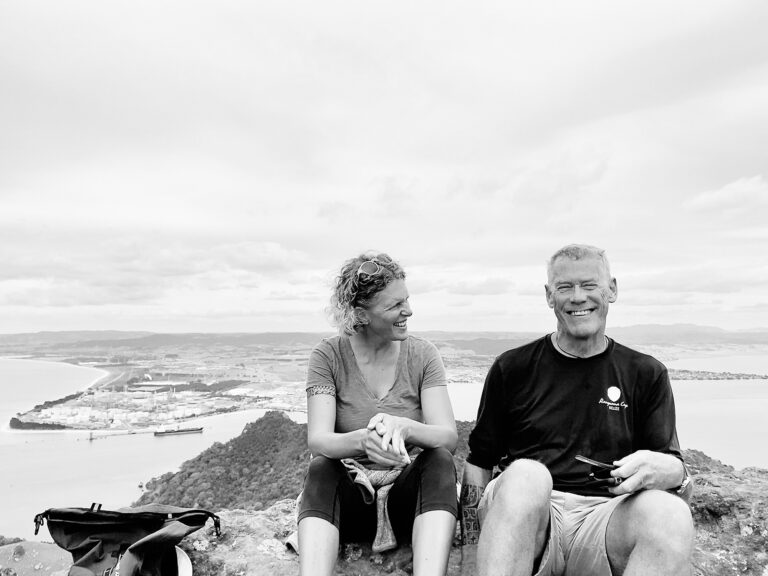
For the designers and builders of cruising catamarans, the first question is often the most challenging: Where will we put the wheel? Some companies prefer mounting a single helm on a cockpit bulkhead, others choose twin steering stations outboard and well aft. Designer Chris White’s signature move is a forward wheel located right in the main cabin; in recent years, other manufacturers have opted for a raised driver’s platform utilizing a dedicated flybridge. It’s kind of confusing. The rule of thumb? There are no rules.
About six years ago, the prolific French builder of cruising cats Lagoon introduced its 450, incorporating one of those flybridges, and it was a resounding success. Thus far, it’s built more than 600 of them. But not everyone loved it. So when it began making plans for model year 2017, rather than scrap the design and start all over, it decided to tweak its 45-footer with a fresh helm station that literally split the difference between the cockpit and flybridge. The result is the 450 S, the initial standing for SporTop. (Lagoon is still building the original model, now known as the 450 F, for flybridge.)
Lagoon isn’t the first company to adopt the midlevel wheel — the one on the 450 S is stationed to starboard — but it’s done an excellent job refining the concept. Four steps up from the cockpit, the broad helmsman’s seat is an arm’s length away from everything needed to operate the vessel. The B&G instrumentation (wind and speed info, chart plotter, auto pilot) are close at hand, as are the controls for the Quick windlass and the twin Yanmar diesels.
All the running rigging, including the overlapping genoa’s sheets and traveler, are also right there, organized in conjunction with a trio of Harken electric winches and a suite of Spinlock clutches. Capping it all is the aforementioned SporTop, a hard bimini with tinted plexiglass that provides good sight lines for the sails.

Besides the aesthetics, which are largely a matter of personal taste — to my eye, the yacht’s profile is a bit cleaner without the flybridge — the position of the wheel allowed designer VPLP to lower both the mast and the boom (the sail area
of the 450 S and 450 F remains the same), which makes the mainsail easier to access and also reportedly dampens the cat’s pitching moment in a seaway. It also gave designers space for a sunbathing deck on the cabin top.
Fans of the 450 F will recognize a lot of the boat’s other features. The double-spreader fractional rig employs outboard shrouds for easy passage along the side decks. A small sprit is mounted on the forward crossbeam for off-wind sails, which are sheeted to a pair of winches in the aft cockpit. That cockpit has a U-shaped settee to starboard and a daybed to port. For lounging, there’s also a long, cozy settee forward of the coach roof, just aft of the trampolines. There are 10 opening hatches on deck and a pair of opening portlights forward on the turret windows.
The U-shaped galley to port is just inside the saloon door and adjacent window that accesses the cockpit. The nav station is just forward of the galley, with a generous L-shaped settee and dining table to starboard. We sailed the three-cabin version with the owners stateroom to starboard and a pair of double cabins to port; one could also opt for four cabins, with one in each end of the boat.
We sailed the 450 S on a light-air day on Chesapeake Bay, with the true wind hovering at around 6 knots, and the boat acquitted herself very well, making over 4 knots hard on the breeze. Tacking through 90 degrees was easy, even in the soft winds, which is not always the case with cruising cats. During motoring tests of the dual 45-horsepower Yanmars in conjunction with our Boat of the Year trials, the 450 S was one of the fleet’s quietest performers.
You can’t really call the 450 S a successor to Lagoon’s earlier version of the boat. But as a worthy sibling, she more than lives up to the title.
Herb McCormick is CW’s executive editor.








